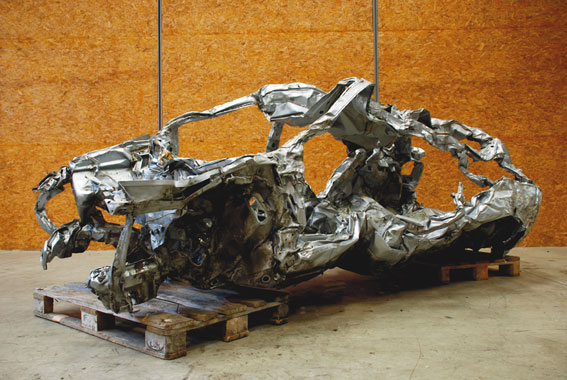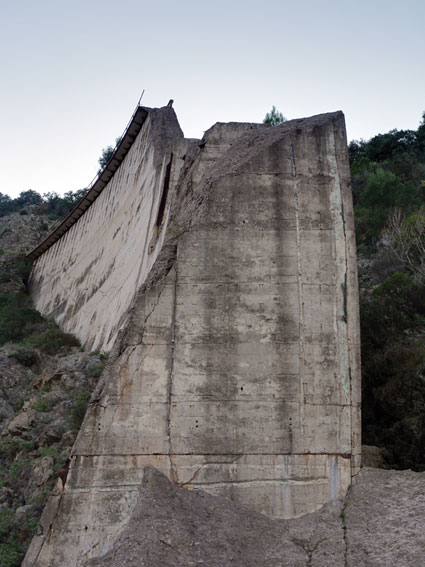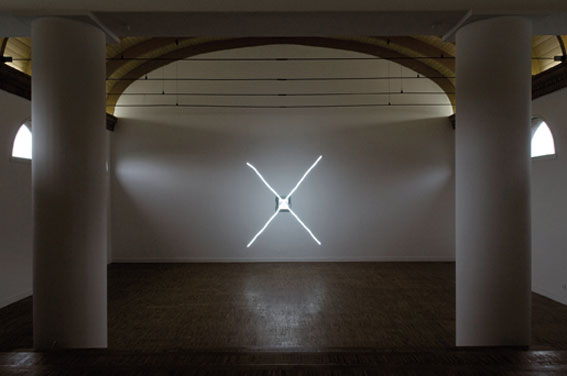Étienne Chambaud, Fabien Giraud et Raphaël Siboni

Deux barrages, Pour en finir avec la Relation
Les années 1990 ont été celles d’une prise de conscience généralisée d’un monde en train de devenir fluide. Les artistes de ladite « esthétique relationnelle » dont les mots d’ordre étaient « flux », « réseau », « synergie » et « communication » ont fait de l’espace une scène, un lieu de relations plus ou moins forcées, où les spectateurs devenaient les acteurs d’une manifestation. L’institution n’était dès lors plus le lieu de la critique mais celui du rassemblement qu’aucune rupture ne semblait pouvoir venir perturber. Les œuvres récentes de Fabien Giraud et Raphaël Siboni et d’Étienne Chambaud considèrent cet univers fluide comme symptomatique de notre temps. Les premiers le nomment la Condition, le second, la Réconciliation.

Fabien Giraud et Raphaël Siboni La Condition, 2009. Châssis de voiture compressée 340 x 170 x 120 cm (vue d'atelier). Photo: Fabien Giraud et Raphaël Siboni. Courtesy des artistes et de la galerie Loevenbruck.
Ce paysage est également celui que Fabien Giraud et Raphaël Siboni nomment « soft » dans une analogie avec l’informatique contemporaine. Nous pourrions dire, en simplifiant un peu, que le langage informatique se divise en deux grands blocs : le hardcode et le softcode. Le premier est le système, gouverné par ce qu’on nomme en physique une constante, soit une quantité dont la valeur numérique est fixe et n’est soumise à aucun changement. Le second est l’horizon idéal du fonctionnement systémique et se définit en opposition au hard. Ses parties sont sujettes à d’infinies variations et tout changement de valeur de l’une d’entre elles modifie définitivement toutes les autres. Le soft est ce qui introduit fluidité, flexibilité et dynamisme dans le système. Dès lors, l’exposition, la situation ou l’institution dans lesquelles ils exposent ne sont plus considérées par ces artistes que comme des variables du système où toute émergence ou singularité semblent menacées de dissolution. Là où Fabien Giraud et Raphaël Siboni emploient les termes du langage informatique, Étienne Chambaud use des mots de la littérature : la Coupure et l’Exclusion face à un système nommé selon le cas Courtoisie, Réconciliation, Relation. Mais dans les deux cas, la question qui se pose alors en filigrane est celle du lieu de l’événement. Si la dispersion des traces et de l’information est infinie et si l’immersion ne laisse plus place à la possibilité d’une rupture, où l’événement peut-il avoir lieu ? Comment faire disjoncter cette réalité fluide ?
Les communiqués de presse de La Contre-Histoire de la Séparation d’Étienne Chambaud au Centre d’art de Vassivière et des expositions La Condition|Le Barrage de Fabien Giraud et Raphaël Siboni à la galerie Lœvenbruck débutent par une injonction similaire : « Coupé, le flux des rivières ! » pour le premier, « Bloquer, les rivières. » pour les seconds. Le vocabulaire est clair, coupure, blocage, séparation. La coupure a une fonction idéologique évidente, elle permet un arrêt, au moins temporaire, l’interruption d’un flux qui permettrait de faire rupture dans l’énoncé quasi liquide de notre Condition ou de creuser un écart dans la Réconciliation et permettrait enfin l’émergence durable d’une situation ou d’un objet. L’événement est peut-être cela même, ce qui vient trahir l’énoncé et qui est, dans ses traces, porteur d’un devenir. Les artistes se rêvent en traîtres.
Dans le travail d’Étienne Chambaud, les Objets Rédimés chutent à la galerie Bugada & Cargnel. Avec le film Contre-Histoire de la Séparation, réalisé en collaboration avec Vincent Normand, Étienne Chambaud « continue à questionner sa notion de ‘Musée Décapité’, un musée d’objets toujours et déjà écrits, un musée qui est autant un lieu d’exposition que d’exclusion ». Ce film est présenté à Vassivière dans la librairie dont l’organisation a été perturbée par l’artiste bloquant par une table de livres, choisis en lien avec les problématiques de la séparation et de la guillotine, l’entrée du spectateur. La librairie est le premier barrage textuel et la coupure déjà se constitue entre la chose et son nom, entre l’objet et les strates de langage et de médiation qui le constituent. Nous en sommes toujours séparés. La vidéo se présente comme un documentaire au cadre chronologique délimité : de l’invention simultanée de la guillotine et du musée (1793) à l’ouverture du Centre Pompidou, année de la dernière décapitation (1977). Une parenthèse historique, de la coupure à la suture. Dès l’entrée, un socle vide, celui de la Victoire de Samothrace, au mur, des cartels en marbre taillés à la mesure des inscriptions, plus loin, l’institution est percée, trouée, coupée, des pierres se dressent à l’étage, maintenues par le poids de balanciers qui traversent le sol. Dans le phare, un mobile s’enfonce dans son socle, maintenu en équilibre par son dehors, par un corps mort placé plus loin, à l’extérieur. Le socle est structure, soutien et ornement. Une rature en néon bloque une fenêtre d’où l’on aperçoit au loin l’image du barrage, raturant par-là même la possibilité de l’île. Étienne Chambaud écrit ici que la suture est un leurre et que l’expérience se forme dans la coupure.
La Contre-Histoire s’écrit ici sur l’île, le lieu même de la Réconciliation, celle qui se croit rattachée au continent, reliée, celle qui a oublié sa séparation essentielle et physique, celle qui refuse sa possible dérive. La Contre-Histoire s’écrit ainsi sur, autant que contre le Symptôme, l’analysant pour mieux le dépasser. Le symptôme, considéré par ces artistes, c’est ce qui apparaît, ce qui fait surface, « la manifestation ponctuelle de dynamiques et de courants souterrains ». Le symptôme fonctionne ainsi comme un signe qui nécessite, pour sa lecture, une position spécifique de l’observateur, la création d’un nouveau regard. Ces artistes ne sont plus face mais dans, sur et contre le symptôme, car la Relation ne permet pas la mise à distance. C’est donc de l’intérieur qu’ils doivent le déconstruire.

Fabien Giraud et Raphaël Siboni Le Barrage, 2009. Photo : Yves Tennevin (Image sous licence Creative Commons). Courtesy des artistes et de la galerie Loevenbruck.
Dans le travail de Fabien Giraud et Raphaël Siboni, la séparation se veut moins violente, mais non moins radicale. À la galerie Lœvenbruck, l’exposition comporte deux titres : La Condition et Le Barrage. Ces deux énoncés nomment d’abord le Symptôme puis une des modalités de sa cure. Mais eux ne coupent pas, ils bloquent. En effet, le barrage est l’artefact qui permet de faire dévier le cours d’une rivière, imposant non pas un arrêt, mais une régulation, la révolution de la matière en énergie. Retournant à l’étymologie du mot, ils considèrent le barrage comme étant l’expression de la rivière, sa manifestation, mais aussi ce qui, lui imposant une pression du dehors (ex pressio), permet son extraction et sa transformation. Les artistes présentent deux sculptures, deux voitures, compressées puis décompressées à la main, disposées l’une au sol et l’autre debout, comme encastrée dans la structure de la galerie, et semblant prendre la mesure de l’espace. L’événement est ce qui se crée dans l’écart provoqué par le redoublement et la répétition. Et une vidéo qui dure le temps d’une journée d’exposition et présente un flux d’images qui explorent et montrent le Barrage. En extrayant deux voitures du flux de leur « Création, Destruction et Récupération », ils tentent d’interrompre le mouvement continu de la création industrielle. L’extraction est le geste qui fait ici barrage, celui qu’ils considèrent comme une condition de l’Evénement. La sculpture devient la possibilité de dresser quelque chose « comme nouveau monde possible ».
Ces artistes, dans leur singularité propre, manifestent dans ces récents travaux leur volonté de faire rupture et d’en finir avec la Relation comme forme : d’un côté la violence assumée de la coupure, de l’autre la nuance du barrage. Ils tentent ici de redéfinir les contours de la notion même d’expérience artistique.
Étienne Chambaud.
Contre-Histoire de la Séparation. Centre International d’Art & du Paysage. Ile de Vassivière. 14 novembre 2010 – 27 février 2011. Commissaire Chiara Parisi.
Objets Rédimés. Galerie Bugade & Cargnel. 19 novembre 2010 – 8 janvier 2011.
Fabien Giraud et Raphaël Siboni.
La Condition. Le Barrage. Galerie Loevenbruck. 10 décembre 2010 – 15 janvier 2011.
TWO BARRAGES
To be done with the Relation
By Ida Soulard
The 1990s were a decade that ushered in a generalized awareness of a world in the process of becoming fluid. Those artists subscribing to « relational aesthetics », whose watchwords were « flow », « network », « synergy » and « communication », turned space into a stage, a place of more or less forced relations, where spectators became actors in an event. Thenceforth, the institution was no longer a place of criticism, but one of assembling or rallying, which no rupture seemed able to interfere with. The recent works of Fabien Giraud and Raphaël Siboni, and Etienne Chambaud regard this fluid world as symptomatic of our day and age. The former call it Condition, the latter Reconciliation.
This landscape is also one which Fabien Giraud and Raphaël Siboni call « soft », in an analogy with contemporary computer technology. We might say, simplifying things a little, that computer language is divided into two large blocks: hardcode and softcode. The first is the system, governed by what is known in physics as a constant, i.e. a quantity whose numerical value is fixed, and not subject to any change. The second is the ideal horizon of systemic functioning, and is defined in contrast to hard. Its parts undergo endless variations and any change of value in one of them alters all the others, in a definitive way. The soft is what introduces fluidity, flexibility and dynamism into the system. Henceforth, the exhibition, the situation and the institution in which they exhibit are no longer considered by these artists as anything other than variables of the system, where any emergence or singularity seems threatened with dissolution. Where Fabien Giraud and Raphaël Siboni use terms from computer language, Etienne Chambaud uses words from literature: Cut and Exclusion in the face of a system called, depending on the case, Courtesy, Reconciliation or Relation. But in both instances, the issue that is then raised, in between the lines, is that of the place of the event. If dispersal of traces and information is infinite and if immersion leaves no place for the possibility of a break, where can the event take place? How can this fluid reality be short-circuited?
The press releases for Etienne Chambaud’s La Contre-Histoire de la Séparation at the Vassivière Art Centre, and for Fabien Giraud and Raphaël Siboni’s exhibitions La Condition|Le Barrage at the Loevenbruck Gallery open with a similar injunction: « Cut, the flow of rivers! » for the first, and « Block, the rivers », for the second. The vocabulary is clear-cut, blockage, separation. The cut has an obvious ideological function, it permits an at least temporary stop, the interruption of a flow that would permit a break to be made in the almost liquid statement of our Condition, or make it possible to create a gap in the Reconciliation, in the end giving rise to the lasting emergence of a situation or object. The event is perhaps that very thing, which betrays the statement and, in its traces, carries a future development. Artists dream of themselves as traitors.
In Etienne Chambaud’s work, the Objets Rédimés fall down onto the Bugada & Cargnel gallery’s floor. With the film La Contre-Histoire de la Séparation, made with Vincent Normand, Etienne Chambaud « carries on questioning his notion of ‘Decapitated Museum’, a museum of objects invariably and already written, a museum which is as much a place of exhibition as one of exclusion ». This film is being screened at Vassivière in the bookshop, whose organization has been disturbed by the artist blocking viewers’ entry by a table full of books, chosen in connection with the issues of separation and the guillotine. The bookshop is the first textual barrage, and the cut is already there between the thing and its name, between the object and the layers of language and mediation forming it. We are always separated from it. The video is presented like a documentary with a delimited chronological framework: from the simultaneous invention of the guillotine and the museum (1793) to the opening of the Centre Pompidou, in the year of the last beheading (1977). An historical parenthesis, from cut to stitch. In the entrance, an empty pedestal, that of the Victory of Samothrace, on the wall, marble notices carved with inscriptions, further on, the institution is pierced with holes and cut, stones rise up on the upper floor, held by the weight of pendulums which cross the floor. In the lighthouse, a mobile is sunk into its stand, kept in balance by its exterior, by a dead weight placed further away, outside. The stand is structure, support and ornament. A crossing-out made of neon blocks a window from where, in the distance, you can see the image of the barrage, thereby deleting even the possibility of the island. Etienne Chambaud here writes that the stitch is a decoy and that the experience is formed in the cut.
The Counter-History is here written about the island, the very place of Reconciliation, the island which thinks it is attached to the continent, connected, the island which has forgotten its essential and physical separation, and which refuses its possible drift. The Counter-History is thus written about, as much as against the Symptom, analyzing it the better to go beyond it. The symptom, as considered by these artists, is what appears, what comes to the surface, « the specific manifestation of underground dynamics and currents ». The symptom thus functions like a sign which, to be read, calls for a specific position on the part of the observer, the creation of a new way of looking at things. These artists are no longer opposite but in, on and against the symptom, because the Relation does not permit any distancing. So it is from inside that they have to deconstruct it.
In the work of Fabien Giraud and Raphaël Siboni, separation is intended to be less violent, but no less radical. At the Loevenbruck Gallery, the exhibition has two titles: La Condition and Le Barrage. These two statements first of all name the Symptom, and then one of the ways of curing it. But they do not cut, they block. The barrage is in fact the artefact which makes it possible to alter the course of a river imposing the revolution of matter as energy, not by a stoppage but by a regulation. Returning to the etymology of the word, they regard the barrage as being the expression of the river, its manifestation, but also what permits its extraction and its transformation by imposing upon it a pressure from outside (ex pressio). The artists present two sculptures, two cars, compressed and then decompressed by hand, one arranged on the floor and the other upright, as if embedded in the gallery’s structure, and seemingly taking the measure of the space. The event is what is created in the discrepancy given rise to by duplication and repetition. And a video which lasts for a day of the exhibition and presents a flow of images which explore and show the Barrage. By extracting two cars from the flow of their « Creation, Destruction and Retrieval », they try to interrupt the continuous movement of industrial creation. Extraction is the gesture which here makes the barrage, the barrage which they regard as a condition of the Event. Sculpture becomes the possibility of erecting something « like a possible new world ».
In their particular singularity, these artists display, in these recent works, their desire to break with and be done with the Relation as form: on the one hand, the assumed violence of the cut, on the other the nuance of the barrage. They make an attempt here to redefine the contours of the very notion of artistic experience.
Étienne Chambaud,
Contre-Histoire de la Séparation, curated by Chiara Parisi. Centre International d’Art & du Paysage, Ile de Vassivière. From 14 November 2010 to 27 February 2011.
Objets Rédimés. Galerie Bugada & Cargnel, Paris. From 19 November 2010 to 8 January 2011.
Fabien Giraud and Raphaël Siboni,
La Condition. Le Barrage. Galerie Loevenbruck, Paris. From 10 December 2010 to 15 January 2011.
articles liés
Céleste Richard Zimmermann
par Philippe Szechter
Julien Creuzet
par Andréanne Béguin
Anne Le Troter
par Camille Velluet


